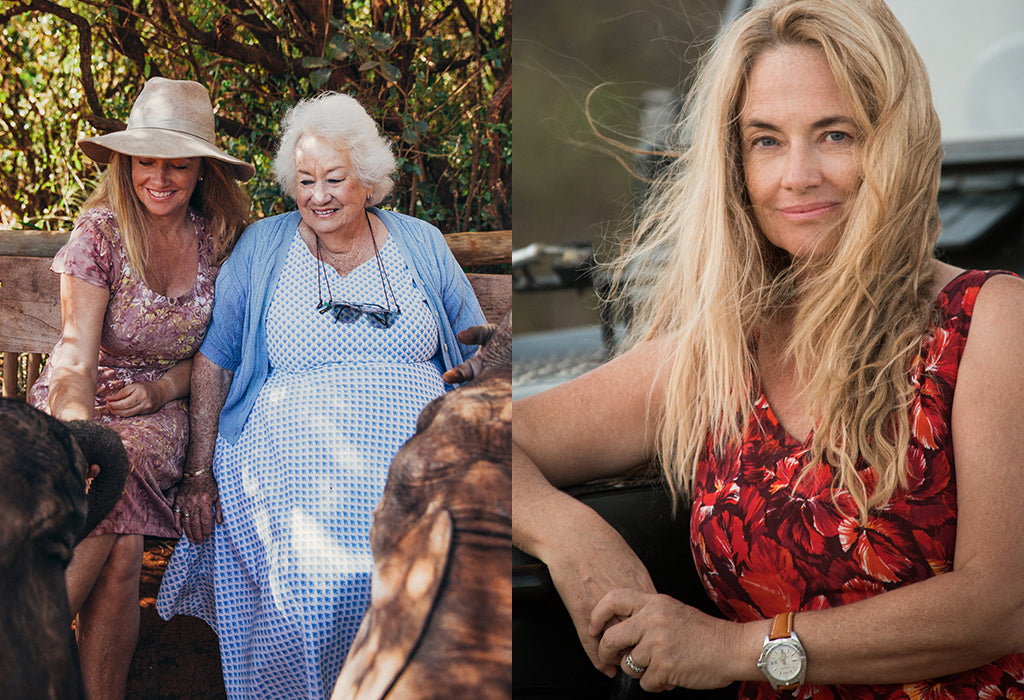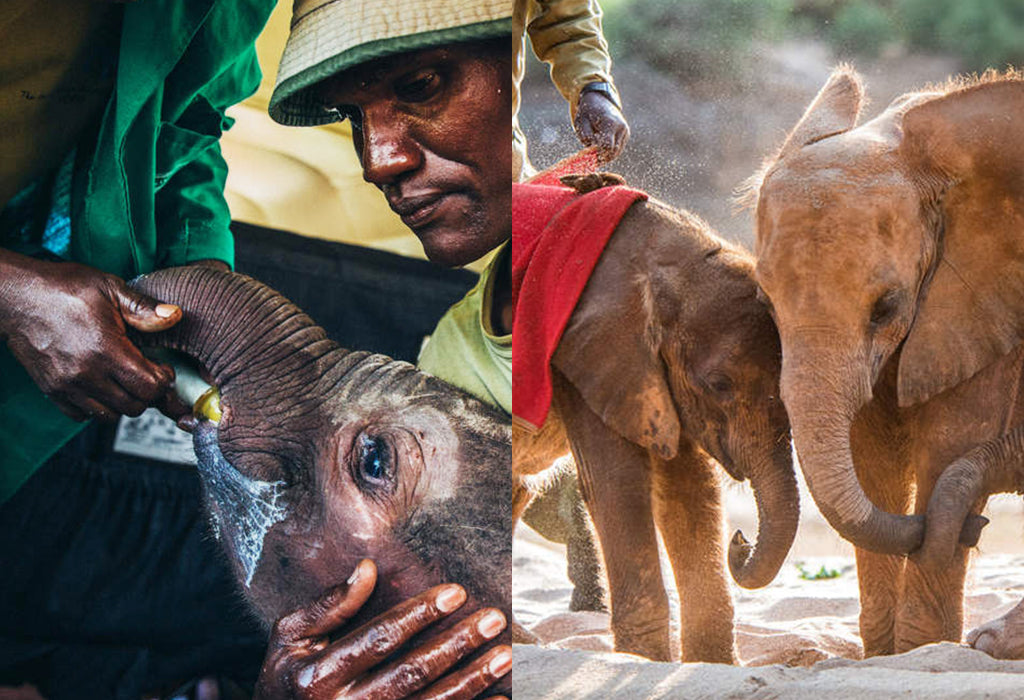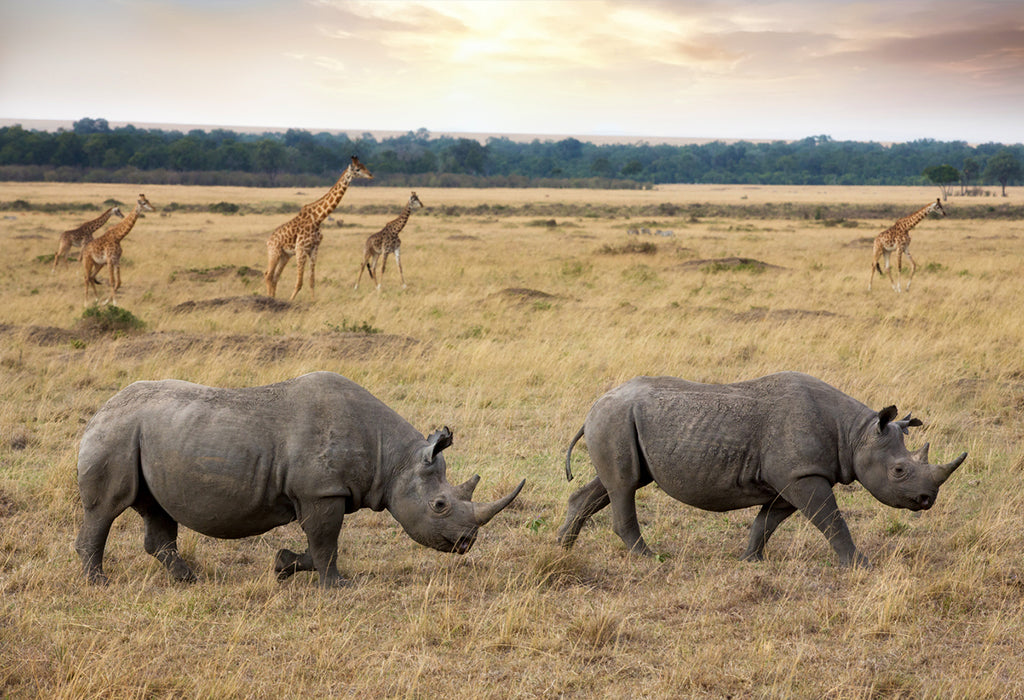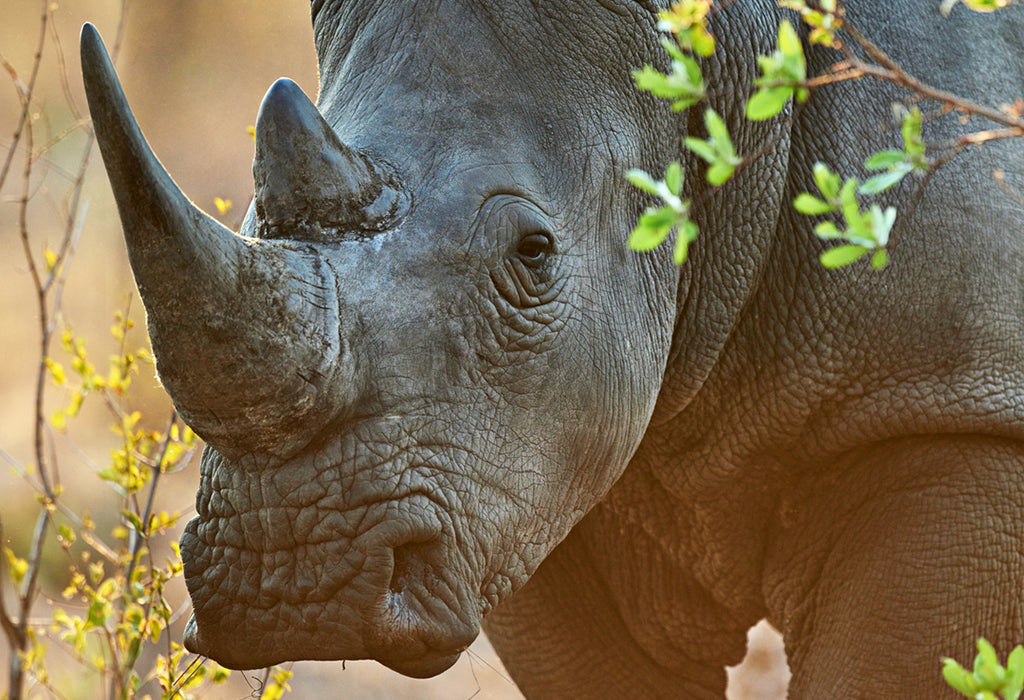
Serious Survivors: Rhino in the Wild
The African rhino population has plummeted 97% since 1960, mostly due to poaching for their horns. The Sheldrick Wildlife Trust in Kenya, known for its successful elephant orphan adoption program, is also working to save wild rhino to help Kenya’s ecosystem thrive.
Here at Chantecaille, we have a special place in our hearts for Sheldrick Wildlife Trust. Ever since Sylvie, Olivier, and Alex Chantecaille traveled to Kenya a few years back to meet with legendary conservationist Dame Daphne Sheldrick and her daughter Angela to witness their pioneering elephant conservation work, the gentle giants have secured their status as Sylvie’s favorite animal. A fast friendship has developed between the families and led to subsequent partnerships.
Daphne Sheldrick founded SWT in a compound in Nairobi National Park in 1977 to honor the memory of her husband, David, who was the founding warden of Tsavo National Park, home to Kenya’s largest elephant population. She was the first to successfully raise infant milk-dependent elephants and rhinos, whom she saved after their mothers had been killed by poachers. Daphne’s method of hand-rearing, along with the milk formula she developed for the infant orphans, made way for the SWT Orphans’ Project, the first and most successful elephant orphan rescue and rehabilitation program in the world.
Since Daphne’s death in 2018 from breast cancer, Angela has passionately carried forward the effort, including a mobile veterinary unit and a wildly successful digital fostering program: For as little as $50 a year, donors can virtually adopt an elephant orphan and receive updates on its progress. This past year, SWT looked beyond orphans to build a rhino conservation area within Meru National Park, below the slopes of Mt. Kenya. Fall’s Luminescent Eye Shades will support this project. Here, Angela discusses elephant and rhino conservation, and growing up Sheldrick.

Your mother, Dame Daphne, founded the Sheldrick Wildlife Trust when you were little. What was it like to be raised in this environment? Did you always know you’d work to continue the family’s conservation legacy?
It was an extraordinary childhood, perfect in every way, living close to nature with so many incredible pets on our front lawn. Life was never dull, nor was I ever short of playmates—and as a result, I grew up with a passion for the natural world. I did have time away living a very different life once I was older, as sometimes one needs distance to truly appreciate what one has: I worked as a makeup artist in the film and fashion industries for ten years after studying art at the University of Cape Town. Finally, in my 30’s, I circled back and knew then that I was ready to truly commit to working together with my remarkable Mum in growing the Trust and continuing this treasured legacy that my parents began all those years ago when I was a child. I feel truly invested in it, and incredibly blessed to have the opportunity to live such a meaningful life.
When did you assume leadership of SWT? What are some of the biggest changes you’ve brought?
I have been at the helm of the Trust since 2001, but not alone. My husband, Robert Carr-Hartley, is very involved in all that we do, although he does have his own bespoke safari business that he runs with his brother. My mother, of course, was very much a part of the Trust all these years until her sad passing last year.
Our involvement in the Trust coincided with the Internet and so we were able to embrace that, develop the digital fostering program, and later use the advantages of social media—all of which have enabled us to share the remarkable work of the Trust with a global audience. When I joined the Trust it was very much about the orphaned elephants; we have since been able to expand to incorporate many other vital projects to complement the raising of the orphans in an effort to keep them safe well into the future.

The elephant orphan “adoptions” model has been hugely effective and now widely emulated. Can you explain the model and why you think it’s been so popular?
We believe the fostering program, designed back in 2001, was the first digital program of its kind. In those days when not everyone had email, it was a great leap of faith to approach this, but we had little option as sending material and information by post around the world required huge administrative overheads that we were not able to afford, and we like to place our emphasis at a field level. Initially, we got very excited with just the few foster parents we had, but over the years this has grown and we have been thrilled by how much it has been embraced—but not wholly surprised. After all, elephants are extraordinary animals and appeal to so many around the world, and many people want to do all they can to ensure their survival and future. The fostering program enables people to be proactive in not just saving a life, but in educating others more about the wondrous ways of elephants.
"My mother and father were the first people in the world to successfully raise and rehabilitate black rhinos—and this all began in the 1950’s."
Have SWT always been involved in rhino conservation, or is this a recent emphasis?
We have always been involved in rhino conservation—in fact, the rhino conservation came before the elephants.. When the Trust was first founded, and through the seventies and the early eighties, the Sheldrick Trust was responsible for creating the first Rhino Sanctuaries in Kenya: Ngulia Sanctuary in Tsavo West National Park and the Nakuru National Park Rhino Sanctuary. David and Daphne, my mother and father, were the first people in the world to successfully raise and rehabilitate black rhinos—and this all began in the 1950’s.

How do elephants and rhinos differ in their personalities?
Elephants are difficult to raise, but easy to reintegrate, because they are such social animals, and as such, an impactful animal nature has made them fragile. Rhinos, on the other hand, have been unchanged for millennia; they are easy to raise, with a strong sense of survival, but very difficult to reintegrate as they are fiercely territorial and very often are prone to killing each other in territorial fights. Elephants are all about loving bonded family groups, and the black rhino are solitary territorial animals.
Can you tell us about how the new fences in the Meru Rhino Sanctuary are keeping rhinos safe?
The Meru Rhino Sanctuary fence is there to keep the rhinos contained in a very large area so that they have increased security to ensure they remain safe. However, while the fences are designed to keep the rhino in, they are not at the exclusion of other wildlife. Cleverly designed corridors ensure that rhinos cannot get through, but elephants and everything else can get both in and out. The sanctuary is in a beautiful area of Meru National Park, with plentiful food and water, and thankfully has been remarkably successful with the population increasing. We were able to contribute further by extending the fence to incorporate more habitat to hopefully further growth in the population of both black and white rhino in Meru.

What’s your proudest moment in the course of your work at SWT?
That is a difficult question to answer as there is not just one moment, but I am very proud of the elephants we have raised from the day they were born. Raising baby elephants is extremely challenging at the best of times, but when a baby has not even had its mother’s colostrum it becomes almost impossible. We have had some miracle babies, however—around six that have quite literally come to us straight from the womb. Some of these newborns that we have raised are grown up and have had babies of their own. To be able to achieve that certainly makes me swell with pride and is deeply fulfilling.
You mentioned a background in makeup artistry—music to our ears! How do you care for your skin in the sun and harsh elements you’re exposed to?
Having been a makeup artist I do have a great love of cosmetics, soaps and creams, essential oils and beautiful scents, and those who know me well know just how much I appreciate these indulgences. Of course, the environment I live in is tough on skin, although I do love the tropics and would not wish to live anywhere else but where the sun shines bright every day. So good product—Chantecaille when I can—and sun creams and a hat at all times are essential.






